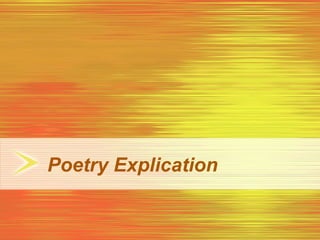
Poetry explication
- 2. Explication vs. Explanation • An explication is a close reading of a single poem or passage of poetry. • The purpose of this exercise to talk about the meaning(s) of the poem primarily in terms of how the poem works. – Consider the diction, stanza and line structure, meter, rhythm and imagery. • A useful explication tries to show how each part contributes to the whole • A good explication requires some basic familiarity with the language of poetry
- 3. Using an Explication • An explication can either be an assignment unto itself or part of a larger assignment that asks for broader analysis and argument. – For example, a ten-page paper on imagery of the sea in Derek Walcott’s poetry might contain explications of four or five poems as evidence for the essay’s claims. • An explication on its own is a set of “microstatements” about the inner workings of the poem, typically giving equal weight to each word, line and stanza. • You’ll still be formulating a strong argument in an explication, but your primary task is to let the text guide you to that argument rather than to come into the poem with a preconceived agenda.
- 4. Guided Questions • About the poem as a whole: – Who is the speaker? – What is the structure of the poem? Two of the most important features to note here are stanza and meter form. – Does the poem fall into an identifiable subgenre— for example, is it a sonnet, ballad, haiku, or dramatic monologue? – What, primarily, is the poem about, and how do you know that?
- 5. Guided Questions • About specific parts of the poem (stanzas, couplets, lines or even individual words): – Diction (word choice): Why has the poet chosen these particular words? What words might she have used instead, and why were they rejected in favor of others? – Imagery: What images does the poem evoke? How are they evoked? How has the poet placed them? How do different images connect or contrast with one another?
- 6. Guided Questions – Literary devices: What kind of figurative language is the poem using—for example, simile, metonymy, hyperbole, apostrophe, or conceit? What about symbolism or literary allusions? – Other aural and visual details: What about punctuation? When read aloud, do the sounds of the words contribute to the poem’s meaning?
- 7. Course of Action • Read the poem straight through once, then read it a second time with a pencil in hand. Your explication should follow the structure of the poem itself, starting with the first line and ending with the last.
- 8. Course of Action • Make several general points about the poem’s structure and main purpose before you start discussing individual lines. – This will save you the trouble of repeating yourself as you go through the text, and help you ensure that your explication is working to relate individual parts of the poem to the poem as a whole.
- 9. Course of Action • Consider three key tasks as you explicate: – First, to take the poem apart into its smallest units and study them on their own terms – Second, to talk about how those units relate to each other – Third, to make some connections between these smaller units and the poem in its entirety. • You may find it useful to work on each of these tasks in this order or it may be easier to put all these different levels of analysis together from the start.
- 10. Course of Action • Remember that poetry explication is a focused type of textual analysis, but that doesn’t mean you don’t have to formulate a thesis. What is the poem doing and how is it doing it? These are the questions at hand; let your close reading guide you to the answers.
- 11. Format of Explication • The explication should begin with the large issues and basic design of the poem and work through each line to the more specific details and patterns. • The first paragraph should present the large issues; it should inform the reader which conflicts are dramatized and should describe the dramatic situation of the speaker. – The explication does not require a formal introductory paragraph; the writer should simply start explicating immediately.
- 12. Format of Explication • The next paragraphs should expand the discussion of the conflict by focusing on details of form, rhetoric, syntax, and vocabulary. • In these paragraphs, the writer should explain the poem line by line in terms of these details, and he or she should incorporate important elements of rhyme, rhythm, and meter during this discussion.
- 13. Format of Explication • The conclusion – The explication has no formal concluding paragraph; do not simply restate the main points of the introduction! • The end of the explication should focus on sound effects or visual patterns as the final element of asserting an explanation.
- 14. Things to Remember • Refer to the speaking voice in the poem as the speaker" or "the poet." – For example, do not write, "In this poem, Wordsworth says that London is beautiful in the morning." – However, you can write, "In this poem, Wordsworth presents a speaker who…" – We cannot absolutely identify Wordsworth with the speaker of the poem, so it is more accurate to talk about "the speaker" or "the poet" in an explication. • Use the present tense when writing the explication. The poem, as a work of literature, continues to exist!
- 15. Things to Remember • To avoid unnecessary uses of the verb "to be" in your compositions, the following list suggests some verbs you can use when writing the explication: • Dramatizes; presents; illustrates; characterizes; underlines • Asserts; posits; enacts; connects; portrays • Contrasts; juxtaposes; suggests; implies; shows • Addresses; emphasizes; stresses; accentuates; enables
